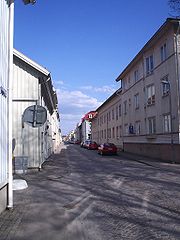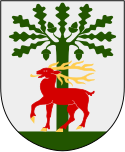Alingsås
 Uliczka w Alingsås | |||
| |||
| Państwo | |||
|---|---|---|---|
| Region | Västra Götaland | ||
| Gmina | Alingsås | ||
| Prawa miejskie | 21 września 1619 | ||
| Powierzchnia | 14,10[1] km² | ||
| Populacja (2018) • liczba ludności • gęstość | 27 266[1] 1934[1] os./km² | ||
| Nr kierunkowy | 0322 | ||
| Kod pocztowy | 441 XX | ||
| Strona internetowa | |||
| Portal | |||
Alingsås – miasto w Szwecji, w prowincji Västra Götaland. Leży nad jeziorami Mjörn i Gerdsken oraz rzeką Säveån.
Miejscowość przecinają drogi E20 oraz Västra stambanan. Prawa miejskie otrzymała 21 września 1619 roku z rąk Gustawa II Adolfa. Jest znana ze swoich kawiarń.
W Alingsås mieszkali m.in. Jonas Alströmer, który wprowadził i spopularyzował w Szwecji ziemniaki, i Karin Boye, poetka.
Przypisy
- ↑ a b c Statistiska tätorter 2018; befolkning, landareal, befolkningstäthet (szw.). Statistikmyndigheten SCB, 2020-03-20. [dostęp 2020-09-08]. [zarchiwizowane z tego adresu (2020-03-24)].
Linki zewnętrzne
Media użyte na tej stronie
Autor: Erik Frohne, Licencja: CC BY 3.0
Location map of Västra Götaland in Sweden
Equirectangular projection, N/S stretching 190 %. Geographic limits of the map:
- N: 59.50° N
- S: 57.10° N
- W: 10.90° E
- E: 15.20° E
(c) Lokal_Profil, CC BY-SA 2.5
This coat of arms was drawn based on its blazon which – being a written description – is free from copyright. Any illustration conforming with the blazon of the arms is considered to be heraldically correct. Thus several different artistic interpretations of the same coat of arms can exist. The design officially used by the armiger is likely protected by copyright, in which case it cannot be used here.
Individual representations of a coat of arms, drawn from a blazon, may have a copyright belonging to the artist, but are not necessarily derivative works.







